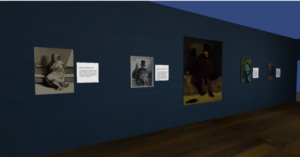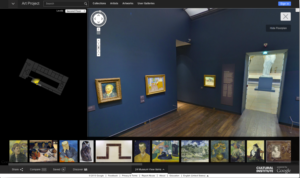The intention behind implementing the second application was to create a virtual environment very similar to a common exhibition space. The inspiration for the virtual room came from the Musée d’Orsay, where the original painting of Dr Gachet is displayed. GoogleArt has used street-view technology to enable a virtual walk-through in the halls of the museum.
However, since then the Google Art website has been redesigned and the street view function inside museums is no longer available. Nevertheless, we still wanted to recreate the virtual art presentation by building an application with very similar properties – it would display all five paintings on one wall, have the same background colour and floor texture and enable a first-person controller navigation.
This lab study compared two different approaches to art presentation in virtual environments, using two different applications (the 3D-video Applicationand and the Unity-gallery Application), which display the same visual content but through different types of interactivity. The 3D-video Application was implemented using a multi-camera capturing system and the 3D Web rendering tool WebGL. The Unity-gallery Application was specifically designed for this lab study and shows the exact same content as the first application but follows the design patterns of a typical gallery space – a rectangular-shaped space with the paintings hanging on a virtual wall. This application was implemented with the game engine Unity. The enabled interactivity in the application is in the form of first-person controller navigation, allowing the user to move in all four directions, and to rotate and tilt the view-point in the virtual scene. The main difference in the enabled interactivity in the two applications is that in the 3D-video Application there is a task that needs to be performed so that the paintings can be viewed. Moreover, continuous feedback is provided by the application, telling users how close they are to finding the correct viewpoint before the 2D image appears. There is no task or feedback in the Unity-gallery Application.
From this study, we can conclude that the application with more interactivity was subjectively valued as more engaging, interesting and fun to use. It was also often described as clever, engaging and interesting to use. The Unity-gallery Application, however, was seen mainly as a virtual gallery where the technology was being under-explored.

